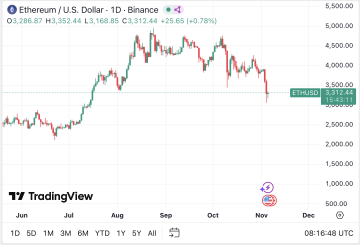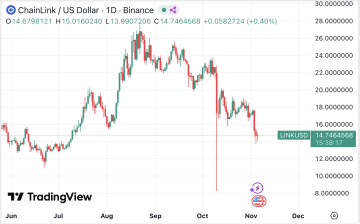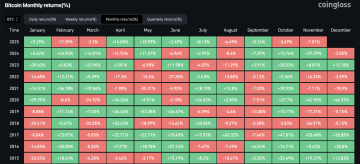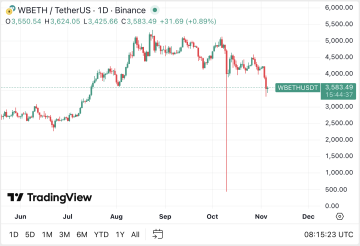October on the Crypto Markets: Trump's tariffs triggered a record decline
November 5, 2025
Tomáš Hucík
What about our porfolio?
After riding a strong uptrend through early October, we faced a major inflection point mid-month. The unprecedented volatility of the October 10–11 crash – the largest single-day crypto wipeout on record – prompted us to secure profits and safeguard capital. We did not initiate any new trades or use leverage, but we closed all open positions (some via automatic stop-loss triggers, others manually) when the market turned. This meant our overall crypto exposure, which had been around 90%, dropped to essentially zero by mid-month. Importantly, every one of our positions was closed in profit, even amid the turmoil. In line with our rules, part of these realized gains, after subtracting operational costs, will be distributed to PBX token holders via StayKing.
If we look at the summary of our positions, each yielded positive results in the end:
Bitcoin (BTC) hit new all-time highs before a flash crash tested our risk management. BTC surged to approximately $126,000 on October 6, fueled by strong institutional inflows. However, a sudden shock came in mid-October when President Donald Trump’s surprise tariff announcement ignited a wave of panic selling. In just 24 hours, over $19B in leveraged positions were liquidated – by far the largest such event in crypto’s history. Bitcoin plunged as low as $104,800 (about a 14% intraday drop) before bouncing back. Remarkably, BTC still managed a month-end close near $110,000, holding above the key six-figure support. We exited our BTC trade with a reasonable profit, thanks to a stop-loss positioned below ~$108K. In the current situation, Bitcoin is under selling pressure, losing the $108K frame support, hoping that the psychological support at $100K will hold.

Source: tradingview.com
Ethereum (ETH) likewise saw extreme volatility. Early in the month, ETH climbed toward the mid-$4,000s, but underperformed Bitcoin slightly during the turmoil. The mid-month crash knocked ETH from ~$4,300 down to about $3,436 at its nadir – a roughly 20% drawdown. This dip aligned with the high-$3K support zone (around $3.6–$3.7K), and buyers stepped in around those levels. By the end of October, Ether had recovered above $4,000, reasserting the market structure support at that psychological level. We closed our ETH position in profit, as our risk measures ensured gains despite volatility. With ETF-related flows still in play, ETH remains fundamentally strong – and we’ll watch for capital rotation once the dust settles.

Source: tradingview.com
Solana (SOL) experienced significant volatility and a classic “buy the rumor, sell the news” pattern. SOL rallied above $250 in early October amid general crypto euphoria (it hit a multi-month high around $253 during late September). However, it was hit especially hard during the crash – Solana briefly plunged by roughly a third, with lows in the mid-$160s (around $168) before finding support. At the end of October, the first-ever spot SOL ETFs launched in the U.S. Despite high anticipation and solid initial trading volume, the catalyst did not spark a sustained rally. Sentiment remains bolstered by institutional interest, but for us, it was prudent to lock in gains given the uncertainty. Therefore, after the position was closed, we did not reopen it again.

Source: tradingview.com
Chainlink (LINK) had been a standout performer over the summer, and though it wasn’t spared by October’s turbulence, it also ended as a successful trade. Despite the round-trip move, our long-held LINK position was closed at a profit (it was well in the green before the drop, and our raised stop-loss ensured an exit above entry). This outcome validates our strategy of focusing on fundamentally strong altcoins – even with heavy volatility, LINK’s Q3 gains (about +30%) provided a cushion. We remain confident in Chainlink’s long-term value proposition, but given the recent instability, taking profit was the judicious choice.

Source: tradingview.com
Binance Coin (BNB) was arguably our star performer, showing remarkable resilience through the chaos. It suffered a milder drop than most altcoins (many saw 30–80%+ plunges), underscoring strong demand for BNB even in turmoil. What followed was impressive: as the market rebounded, BNB surged to a new all-time high of $1,370 by October 13. We closed our BNB position at a substantial profit, capturing gains from this extraordinary run, although in overall consideration it was the smallest one size-wise.

Source: tradingview.com
All of these positions were closed out profitably, with BNB’s result being exceptionally strong. The mid-October crash was a stark reminder that altcoins can be more volatile and vulnerable in downturns – as we had cautioned before, many alts underperformed Bitcoin significantly (often by 10–20 percentage points). When volatility peaked, liquidity vanished on some exchanges, and a few altcoins plunged by over 90% for a short period. Thanks to proactive risk management (tightening stop-losses as prices climbed), we protected our gains when the market reversed. As a result, our portfolio’s equity remains intact, and we’ve converted paper profits into realized gains, putting us in an excellent position to redeploy capital when the time is right. For now, we’ve decided to pull capital from the market to preserve cash, consistent with our core strategy – our trading is a by-product, while project development remains the primary focus. Considering future development, we still continue to think in scenarios rather than single-point forecasts. With our portfolio now in cash after this volatile month, we’re evaluating the landscape for the next strategic entry. Levels below are zones, not exact ticks, but they frame our outlook going forward.
Considering future development, we continue to think in scenarios rather than single-point forecasts. With our portfolio now in cash after this volatile month, we’re evaluating the landscape for the next strategic entry. Levels below are zones, not exact ticks, but they frame our outlook going forward.
Summary of developments in October 2025
Breakout and Flash Crash
October 2025 was truly a tale of two halves. In the first week, crypto markets built on their Q3 momentum – Bitcoin burst through its previous peak to hit record highs (~$125–126K), and enthusiasm spilled into many altcoins.
However, by mid-month, this euphoria met a sudden shock. On October 10, news of a 100% U.S. tariff on Chinese imports – an unexpectedly aggressive move by President Trump – roiled all risk assets. Crypto bore the brunt as panic selling spread across exchanges.
The global crypto market cap plunged by roughly $400 billion in a single day, the largest daily loss ever recorded. A cascade of liquidations (over $19B in leveraged longs blown out) sent prices into freefall. By the end of that capitulation on Oct 11, essentially all short-term excess leverage had been flushed from the system
Recovery and Cautious Optimism
Following the crash, the market found footing and began to heal. Cooler heads noted that the sell-off was worsened by structural factors (liquidity gaps, algorithmic trades) and that the tariff shock was likely a negotiating tactic.
Indeed, President Trump softened his stance days later, and China refrained from escalation, which helped calm the markets. Bitcoin rebounded above $110K, and Ethereum climbed back over $4K, showing that fundamental demand persisted.
Investor sentiment swung dramatically – the Crypto Fear & Greed Index went from “Greed” to “Extreme Fear” in mere days – but then gradually improved as prices stabilized. Another key event was the launch of several altcoin spot ETFs in late October (including funds for Solana, Litecoin, and others), marking further institutionalization of the crypto space.
However, the immediate market reaction to these launches was muted or even negative – a classic “sell the news” effect as SOL and others ran up beforehand and dipped after trading began.
Looking ahead, November and beyond present an interesting setup. Historically, the final two months of the year are among crypto’s strongest. If the market has truly purged excess leverage, a more stable foundation could allow renewed upside.
Still, we remain vigilant: the October crash underscored how sensitive crypto is to geopolitical shocks. Any new tariff scares or macro surprises (unexpected data, central bank actions) could trigger another volatility wave. Moreover, profit-taking behavior has increased — traders are derisking across the board, gently pressuring prices lower.
October 2025: Crypto Market Macro Recap and Key Events
Crypto traders call October "Uptober," a play on words from the English October, which expresses that prices typically rise in October. However, October 2025 probably disappointed optimistic expectations in this regard. Instead of new highs, this month brought a rapid decline in the middle of the month and significantly increased volatility.

Source: coinglass.com
Fed Eases Again, But Hints at a Pause
The U.S. Federal Reserve delivered another quarter-point interest rate cut at its late-October meeting, bringing the target range down to 3.75%–4.00%. This marked the Fed’s second cut of the year, a move widely expected since September’s projections.
Uniquely, the decision came amid a month-long federal government shutdown, which deprived policymakers of fresh economic data (jobs, inflation, etc.). Fed Chair Jerome Powell admitted that the data “fog” made policymaking trickier, comparing it to “driving through the fog”.
The October rate cut also saw unusual dissent within the Fed – one governor wanted a deeper 0.50% cut, while another preferred no cut at all. Powell noted “strongly differing views” about whether to cut again in December, signaling that further easing is not a foregone conclusion.
In short, October reinforced the Fed’s dovish turn, but also introduced uncertainty about how much more easing may follow.
Trade War Shock Triggers Record Crypto Flash Crash
Mid-October brought one of the most violent crypto crashes on record, showing how sensitive digital assets remain to geopolitical shocks.
On October 10, President Trump’s abrupt 100% tariff announcement on Chinese imports (and export curbs on critical tech) sent shockwaves through global markets. With traditional markets closed overnight, crypto — trading 24/7 — bore the immediate brunt.
Within hours, 1.7 million traders were liquidated, and about $19B in leveraged positions were wiped out. Bitcoin plunged from $122K to as low as $104K, a 14% drop, while Ethereum sank over 12% to ~$3,436.
This flash crash now stands as the largest single-day wipeout in crypto history, even surpassing 2020’s Black Thursday and the FTX collapse in 2022. Analysts noted that elevated leverage made the market fragile – once prices fell, margin calls and poor liquidity accelerated the collapse.
By Oct 11, over $19B in positions evaporated, sentiment was badly shaken, and confidence only returned after U.S. and China softened their tone.
Still, the episode was a stark reminder: even in a bull market, macro surprises can unleash “mini crypto winters” overnight.
Altcoins Hit Harder
Smaller cryptocurrencies suffered outsized losses and struggled to recover, showing a flight to quality toward Bitcoin. In the worst 24-hour period, many altcoins fell 30–60%+, while Bitcoin and Ether saw smaller drops.
For example, Dogecoin (DOGE) plunged 60% intraday, and Avalanche (AVAX) collapsed ~70% before stabilizing. Even after partial recoveries, damage was severe – by late October, Bitcoin was down 5% for the month, while the altcoin index fell around 8%.
Major “ETH killers” and DeFi tokens underperformed: Solana, BNB, and Ethereum each notched weekly losses of 4–7%, and Cardano and Dogecoin remained 20%+ below pre-crash levels.
On-chain data suggested capital rotated into Bitcoin, boosting its market dominance as investors sought relative safety. Analysts like Willy Woo highlighted that BTC’s investor flows held steady while ETH inflows dropped sharply, indicating risk consolidation rather than full exit.
Exchange Stress Tests and Binance Glitches
The October crash also exposed vulnerabilities in crypto trading infrastructure. Several major exchanges struggled to handle extreme volatility.
The most notable issues arose on Binance, where wrapped tokens and derivatives imploded in price as liquidity evaporated.
For instance, wBETH fell 88% below its peg, BNSOL dropped to one-fifth of its value, and even Ethena’s USDe stablecoin briefly de-pegged to $0.65 before recovery.
Binance acknowledged the disruptions, apologized to users, and launched a $283M compensation plan, later expanding it to a $400M Recovery Fund to restore confidence.
The incident reignited debate about risk management practices and exchange resilience, reminding everyone that even top-tier platforms can face flash-crash breakdowns under stress.

Source: tradingview.com
Altcoin Spot ETFs: A New Milestone
In late October, multiple spot ETFs for top altcoins debuted in the U.S., marking a major step toward mainstream adoption. The NYSE and Nasdaq listed funds tracking Solana, Litecoin, and Hedera, even while the SEC was partially offline due to the shutdown.
These new ETFs extend the crypto ETF boom beyond Bitcoin and Ethereum, offering regulated exposure to a broader basket of digital assets. Some even include on-chain staking rewards.
Long term, this represents a regulatory turning point – the SEC’s streamlined approval process effectively opened the floodgates for more crypto funds. This institutional expansion legitimizes additional protocols, deepens market liquidity, and tightens correlation between crypto and traditional finance.
Overall, October’s altcoin ETF launches mark a new chapter of integration between crypto and Wall Street, underscoring that the asset class’s maturation is in full swing.

Veškeré informace uvedené v tomto článku a jeho obsah nemá sloužit jako investiční poradenství, doporučení či závazný návod k finančnímu rozhodování. Společnost Probinex nenese odpovědnost za jakékoli rozhodnutí učiněné na základě těchto informací. Každý čtenář by si měl před jakýmkoli investičním krokem provést vlastní analýzu a případně konzultovat odborníka.



